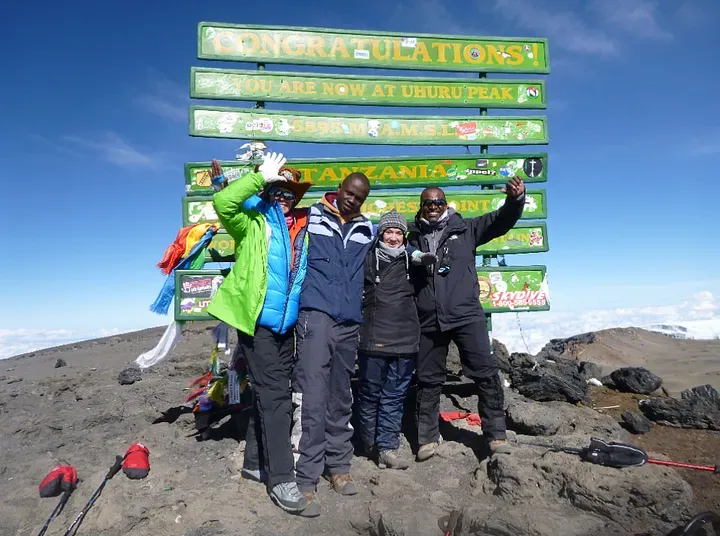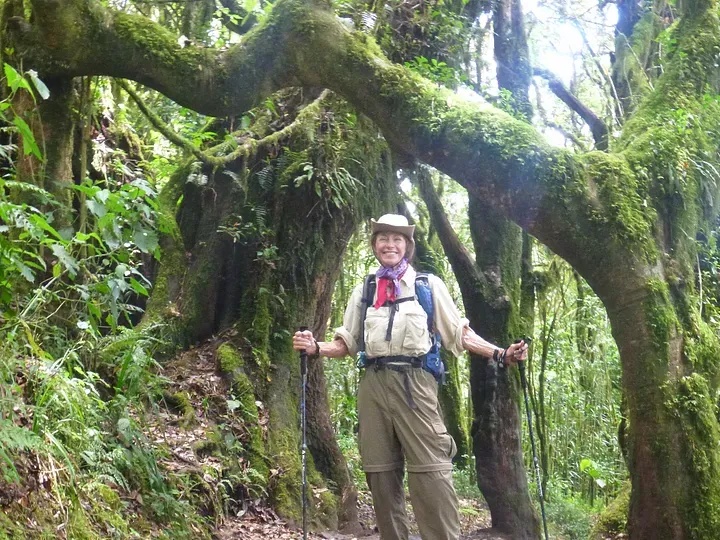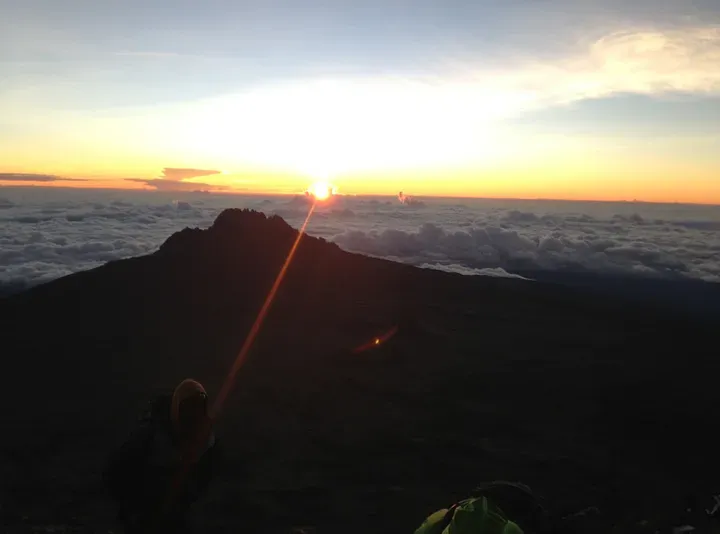
It's okay to review the past as long as it serves the future, so today I celebrate ten years ago
Summit night 2013 was clear. A full moon was listing overhead when we finished our rice and protein mega-meal in preparation for the Kilimanjaro summit attempt. Other than the bright moonlight, it was dark and damned cold. A few scattered headlamps bouncing around like a lineup of distant fireflies above us located a few teams which had gotten an early start on the summit climb.
About six hours later, my guides, August and Ignas (above), my climbing partner Aurelie and I stood underneath the iconic sign. I frankly have little memory of that moment, I was both water- and oxygen-starved. My insulated water line had frozen solid. Despite Ignas' best efforts, we couldn't dislodge enough ice for me to get hydrated.
I'd hallucinated, got nauseous, but made it anyway. I denied being sick like everyone does, but I did get mild altitude sickness. It comes with the territory. It's part of the sickness to deny you have it. The guides know that, and they also know how to gauge whether or not you're able to continue, and how to do it safely.
While no real numbers are available, the best bet is that about 350,000 people have stood under this sign. Some 110,000 head up every year; of that (estimates vary wildly) between 35-50,ooo attempt. A great many fail.
Your best chance is to train seriously, hire an experienced team with medical training and a long history of success, commit to educating yourself on altitude sickness, and get ready for a long, hard slog before you start, while you climb, and an even harder slog as you descend.
The down part is what nobody writes about. The down part is what often kills Everest climbers who fail to understand that a good third or more of the trip is yet to come, after all that work. It's when most people die.
We train for the up, and fail to keep reserves for the down.
If that's not a life lesson I'm not sure what is.
Coming down Kili is a lesson in humility if you're not a skier. In our case, Aurelie was, and she zoomed past me effortlessly as I struggled to stay upright. I'm a mountain goat on the up, and a whack job coming down.
I tried to be Aurelie, so of course I skidded in the scree into a big rock, cranked my knee. Then I was airlifted, if you will, by Ignas and August on their strong shoulders to base camp, where we rested (I collapsed) packed up, and headed down the mountain.
By the time I got back to the hotel, the whole experience was barely a dream. You spend so little time on the summit that it passes like a sneeze. You have to return to base camp because others are coming. Besides, after all that, you have to clear out of base camp, because, natch, more are coming to head up for their own summit night.
Grand Central Kilimanjaro. It's a big business, and not much time to really take in the best show at the top. Part of that is your safety; there is a long way to go before you can rest after summit night.
I made it, with help. How often we forget to acknowledge that our guides make it possible, our porters do the hard labor of schlepping our shit up the mountain, and we love to assume that it was all us.
Such endeavors rarely are. We make it to the top because our support teams do it all the time. For guides and porters, it's another day at work. We train for months just to make it to the top once; our guides do it all season long.
What I did, especially compared to many others who have summited this and other, harder mountains while much older, disabled, blind or obese (the list really is endless) was meaningless in the largest sense. But as with all such endeavors, what it did for the individual, the message that I got from all that effort and the doors it opened for me, is what matters.
It was the beginning of a breathtaking decade. Now, ten years later, I am recovering from all the necessary work which will, at least to a degree, make it possible for me to do other challenging things, should I wish.
The "should I wish" is what's key here.
Ten years ago I couldn't possibly have imagined living in Oregon, being close to the coast, surrounded by firs and all the beauty that I take in every day. Ten years ago I couldn't have imagined all the adventures that followed after I came down that mountain.
I also couldn't have imagined five plus years of surgeries with all the challenges that came with them, including very long recovery times and endless PT.
While I had planned to do Kili again this very night, a bookend to that decade as it were, that wasn't the right move. I made the right moves, and now am on a steady, gentle comeback trail.
I have no idea what's on the next horizon other than a few more procedures (hell, after twelve surgeries, I feel like I can take on anything).
The worst of it is over. Maybe I better not say that. I hope the worst is over.
Still.
I trained for the down part. Kilimanjaro taught me that. I listened to those climbers who told me what most folks never mention: how hard it is to safely get back down, then recover.

How we have to hold some of our endurance in reserve. How we have to prepare mentally for the hike down, which is fraught with peril for exhausted climbers still starved for oxygen. It was still very difficult, beyond what you might think when you start that long hike, "it's all downhill from here."
We spend so much time preparing for the up, the summit, for life's beautiful moments in the sun that we aren't prepared enough for the down.
There have been a lot of ups during my twelve years of adventure travel. I loved every one of them. However, they are incredibly rare.
There were a lot more downs: the injuries, the accidents, the recovery. Bad guides, bad guests, bad food, bad weather and in several cases, countries I will never revisit. There were ruined trips, ruined experiences, lost money and lost lunches from illness, stolen money on multiple occasions, lost cameras, stolen clothing.
The blisters, the broken bones, the sprains, the busted ribs and concussions. The horses that hated me enough to toss me at a dead run. The inept and rude tourists who ruined the trips for everyone. It happens.
Sometimes you're that tourist. That happens, too. Like it or not, you do this long enough and you get your turn in the asshole barrel, so to speak.
You learn to survive in the down. You train for the down. There's plenty of it. But when there is an up moment, it is even better for all the rest of it. It's been earned, like that sunrise at Gilman's Point.
Ten years ago I did something amazing, for me. Not for the capable, competent, talented guides and porters who do it daily. For me. I turned that into an adventure travel career. Today, as I continue to heal, train and consider my options going forward, I get to look at new horizons ahead.
The sun is coming up over those horizons, too.
I can't wait.

Dear Walkabout Saga Reader:
Thank you so much for taking a few minutes out of your life to read my work. WalkaboutSaga is an act of love and devotion, and I hope that you found value in it.
If my work appeals to you, may I kindly invite you to consider joining those Patreon supporters whose generosity keeps the gas in my tank as it were.
Such articles take time, resources, research and effort. Even a small amount of support truly helps me keep this going. In challenging times, I recognize that even a small amount is hard. Those who can give, I appreciate it. Those who cannot, I hope my words are helpful.
My purpose is to Move People's Lives. I can do more of that with your help.
Thank you.
You can explore that option here.
However you decide to partake of my writing, again, thank you.
Comments powered by Talkyard.